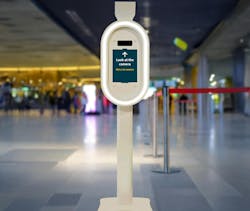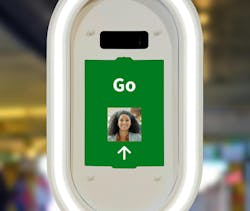Biometric Fast Pass: How On-the-Move Screening is Reshaping U.S. Airport Operations and Revenue Models
Five Things You'll Learn from This Article

-
How on-the-move biometric screening dramatically increases passenger throughput—processing up to 20 travelers per minute compared to 1–2 with traditional methods.
-
Why leading U.S. airports like MCO, LAX, and MIA are adopting biometric systems to reduce queue times, minimize missed connections, and improve passenger satisfaction.
-
How modern facial recognition outperforms human officers in accuracy, backed by real-world performance metrics and academic studies.
-
What questions airport leaders should ask vendors about data privacy, compliance, and long-term system adaptability to future regulations.
-
Why inclusive design and off-the-shelf hardware matter for scalable, passenger-friendly deployment across diverse airport environments.
While biometric systems have been in use for nearly a decade, a new phase of adoption is taking root: walk-through, on-the-move screening that prioritizes throughput, security, and convenience. According to Dominic Forrest, Chief Technology Officer at iProov, these capabilities aren’t just technological upgrades—they’re reshaping the airport experience for travelers, officers, and the bottom line.
“What this is doing is optimizing the processing of the low-risk people and actually freeing up a lot of resource to focus on those who may be less low risk,” Forrest said in a recent interview.
A Shift from Kiosks to Continuous Flow
Traditional biometric screening—through kiosks or e-gates—has long required travelers to stop, scan a document, and wait for a match. The new model in use by U.S. Customs and Border Protection (CBP) under the Seamless Border Entry (SBE) and Enhanced Passenger Processing (EPP) programs allows eligible travelers to be processed in motion.
“In airports where SBE is deployed, as you walk toward the officer, your image is being captured and matched before you even arrive at the desk,” Forrest explained. “By the time you get there, the officer sees a green light and can say, ‘Welcome to the United States.’”
This system allows up to 20 people per minute to pass through a single officer checkpoint—far exceeding the estimated one or two passengers per minute under manual processing.
From an operational standpoint, this shift has several implications:
-
Staffing efficiency: Border officers can spend more time on higher-risk passengers while processing trusted cohorts faster.
-
Queue time reduction: Published CBP data at airports such as Orlando International Airport (MCO) show significant reductions in wait times following implementation of EPP.
-
Missed connection mitigation: Reducing wait times at customs can decrease missed flights—a major operational and financial burden for airlines and airports alike.
“We’re no longer talking about incremental improvements,” Forrest said. “This is an entirely new throughput model.”
Better Tech, Better Outcomes
One of the early concerns with facial recognition has been fairness and accuracy, particularly across race, age, and other demographics. But Forrest points out that these worries, while once valid, have largely been addressed by advances in machine learning and facial recognition algorithms.
“Face matching algorithms today are far better than human officers at recognizing people,” he said. A study published in PLOS ONE by White et al. (2014) confirms this. The research, which evaluated passport officer accuracy in matching facial photos, found a 14% error rate among trained professionals—a figure significantly higher than that of today’s leading biometric algorithms.
In the United States, iProov systems used in SBE and EPP programs don’t perform the facial match themselves—that function is handled by CBP’s Traveler Verification Service (TVS), which holds one of the strictest image quality standards in the world. According to Forrest, iProov’s systems have processed millions of passengers without a single failure to meet TVS image quality thresholds.
“Sooner or later we’ll miss one,” he added, “but 100% success rate so far is a remarkable achievement.”
Equally notable is the use of commodity hardware in these deployments. Rather than installing large, expensive e-gates, the iProov model can use off-the-shelf equipment.
“You can buy the cameras we use at Best Buy or Amazon,” Forrest said. “This means airports don’t have to lock into costly, proprietary ecosystems. Operationally, it’s far simpler.”
Designing for People, Not Just Infrastructure
Forrest emphasized that biometric systems—when properly deployed—enhance rather than replace the human element. Officers still play a central role in decision-making.
“What it gives the officer is time,” Forrest said. “Instead of fumbling with a passport and trying to match a photo, they already have that information and can focus on their training, instinct, and the conversation.”
From a staffing perspective, the system requires minimal adaptation. Officers receive upfront training, and iProov staff remain on-site during rollout to fine-tune camera positioning and environmental adjustments, such as lighting.
“In most deployments, the officers are no longer stuck behind a glass booth,” Forrest said. “They’re out front, closer to the traveler. It actually improves the personal interaction.”
This user-first mindset also applies to inclusivity. Forrest points out that biometric systems must work equally well for all travelers—whether it’s a parent carrying a child, someone in a wheelchair, or a person arriving after a 12-hour flight.
“You can’t optimize for ideal conditions,” he said. “You have to build a system that works under real-world, uncontrolled scenarios.”
Preparing for the Future: Compliance and Scalability
As adoption grows, so do questions about data protection, consent, and compliance. Forrest acknowledges that the regulatory landscape is nuanced—especially when considering international operations. In Europe, for example, the General Data Protection Regulation (GDPR) prohibits storing facial data in ways that U.S. laws may allow under exemptions for border control.
“iProov is a UK-based company, so we’re GDPR-compliant by default, even for U.S. operations,” Forrest said. “That means our systems are built to meet some of the highest privacy and compliance standards globally.”
For airport leaders, evaluating biometric systems should involve a few key questions:
-
How does the system perform under real conditions?
-
What are the throughput rates per officer or lane?
-
Is the vendor responsible for updates, replacements, and compliance over time?
-
Does the system support inclusivity and equitable performance?
“Are you buying a one-off product, or a long-term platform that evolves with your airport’s needs?” Forrest asked. “That distinction matters.”
A Tipping Point for U.S. Airports
Biometric screening is no longer emerging technology—it’s operational infrastructure. Airports such as MCO, LAX, and MIA are showing what’s possible when biometric systems are implemented with thoughtful design, clear operational benefits, and strong governance.
The ability to process more people with fewer resources, while improving both security and satisfaction, is a rare win for airport management, airlines, and passengers alike.
“Somebody asked me recently, ‘When did crossing a border become fun?’” Forrest said. “That’s the level of transformation we’re seeing.”
For airports preparing to modernize and grow in the face of labor constraints and rising traveler expectations, biometrics may be the best investment they haven’t fully explored—yet.
About the Author
Joe Petrie
Editor & Chief
Joe Petrie is the Editorial Director for the Endeavor Aviation Group.
Joe has spent the past 20 years writing about the most cutting-edge topics related to transportation and policy in a variety of sectors with an emphasis on transportation issues for the past 15 years.
Contact: Joe Petrie
Editor & Chief | Airport Business
+1-920-568-8399
>> To download the AviationPros media kits, visit: Marketing Resource Center
>>Check out our aviation magazines: Ground Support Worldwide | Airport Business | Aircraft Maintenance Technology



